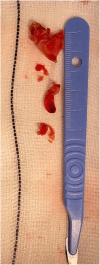X marks the spot: catheter aspiration using the Inari FlowTriever device to debulk defibrillator lead vegetations prior to transvenous lead extraction-a case report
- PMID: 39045529
- PMCID: PMC11263866
- DOI: 10.1093/ehjcr/ytae332
X marks the spot: catheter aspiration using the Inari FlowTriever device to debulk defibrillator lead vegetations prior to transvenous lead extraction-a case report
Abstract
Background: When cardiac implantable electronic device infection occurs, standard therapy is usually total system extraction. Transvenous lead extraction is preferable to open heart surgical extraction, unless contraindicated because of the presence of very large vegetations on the intravenous leads according to the European Society of Cardiology guidelines. Extraction of transvenous leads with vegetations risks distal embolism resulting in obstruction and/or infection in the pulmonary arteries. Catheter aspiration of vegetations or thrombi has been performed prior to transvenous lead extraction using a partial veno-venous extracorporeal bypass circuit. We report the use of a single-access aspiration system using the Inari FlowTriever 24 French system to debulk a defibrillator lead before percutaneous extraction.
Case summary: A 79-year-old male presented with fever 18 years after his first implantable cardioverter defibrillator implant and 9 years after his most recent pulse generator change. Two large vegetations were identified on his transvenous defibrillator lead on the atrial aspect, near the tricuspid annulus, which were aspirated using the Inari Medical 24Fr FlowTriever aspiration catheter. We describe anatomical considerations during the approach and a technique to localize the vegetations based on a combination of fluoroscopy and transoesophageal echocardiogram guidance.
Discussion: This case demonstrates the safe and effective use of the Inari Medical 24Fr FlowTriever aspiration catheter in debulking a defibrillator lead before transvenous lead extraction. This method uses a single venous puncture and is not dependent on extracorporeal bypass. Apart from reducing complexity, this technique may be advantageous in patients where anticoagulation needs to be minimised.
Keywords: Aspiration; CIED; Case report; Defibrillator; Endocarditis; Vegetation.
© The Author(s) 2024. Published by Oxford University Press on behalf of the European Society of Cardiology.
Conflict of interest statement
Conflict of interest: None declared.
Figures





References
-
- Greenspon AJ, Le KY, Prutkin JM, Sohail MR, Vikram HR, Baddour LM, et al. . Influence of vegetation size on the clinical presentation and outcome of lead-associated endocarditis: results from the MEDIC registry. JACC Cardiovasc Imaging 2014;7:541–549. - PubMed
-
- Kusumoto FM, Schoenfeld MH, Wilkoff BL, Berul CI, Birgersdotter-Green UM, Carrillo R, et al. . 2017 HRS expert consensus statement on cardiovascular implantable electronic device lead management and extraction. Heart Rhythm 2017;14:e503–e551. - PubMed
-
- Delgado V, Ajmone Marsan N, De Waha S, Bonaros N, Brida M, Burri H, et al. . 2023 ESC guidelines for the management of endocarditis. Eur Heart J 2023;44:3948–4042. - PubMed
-
- Klug D, Lacroix D, Savoye C, Goullard L, Grandmougin D, Hennequin JL, et al. . Systemic infection related to endocarditis on pacemaker leads: clinical presentation and management. Circulation 1997;95:2098–2107. - PubMed
Publication types
LinkOut - more resources
Full Text Sources
